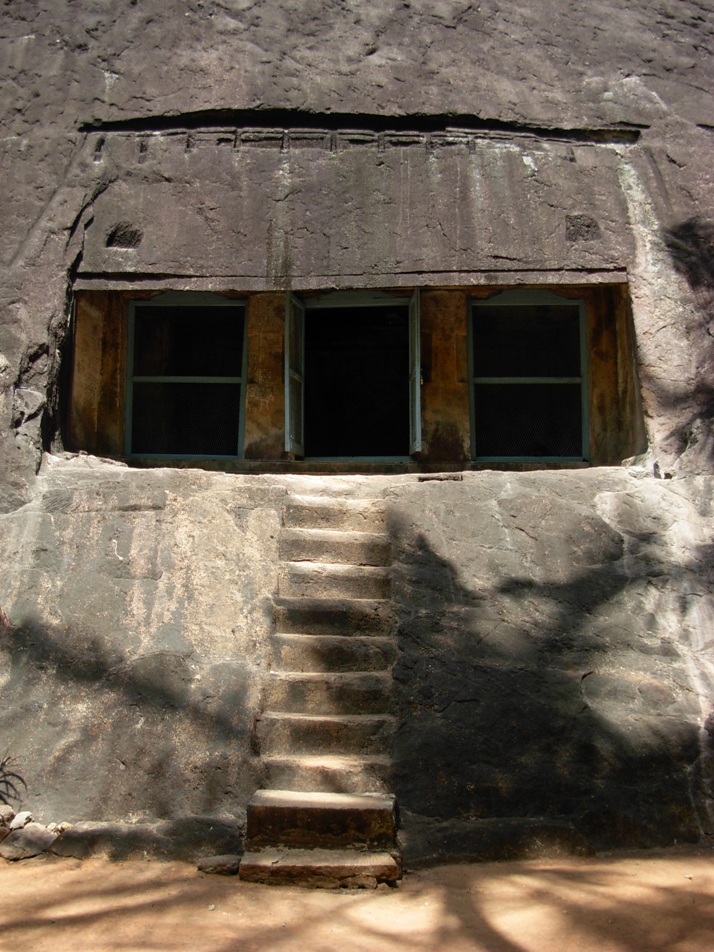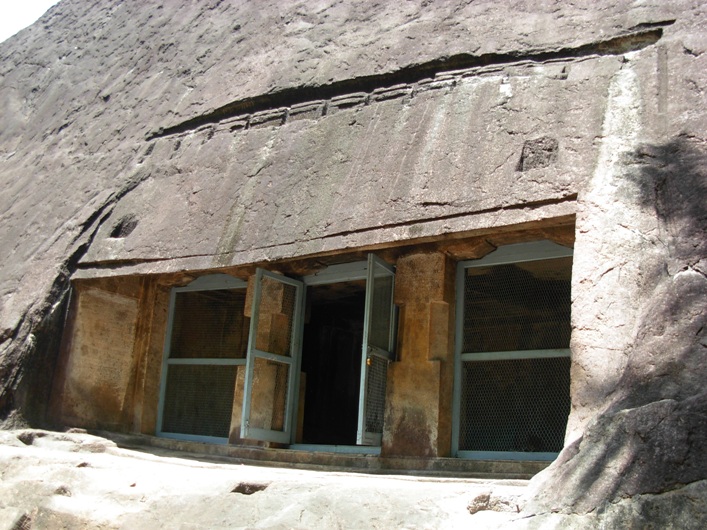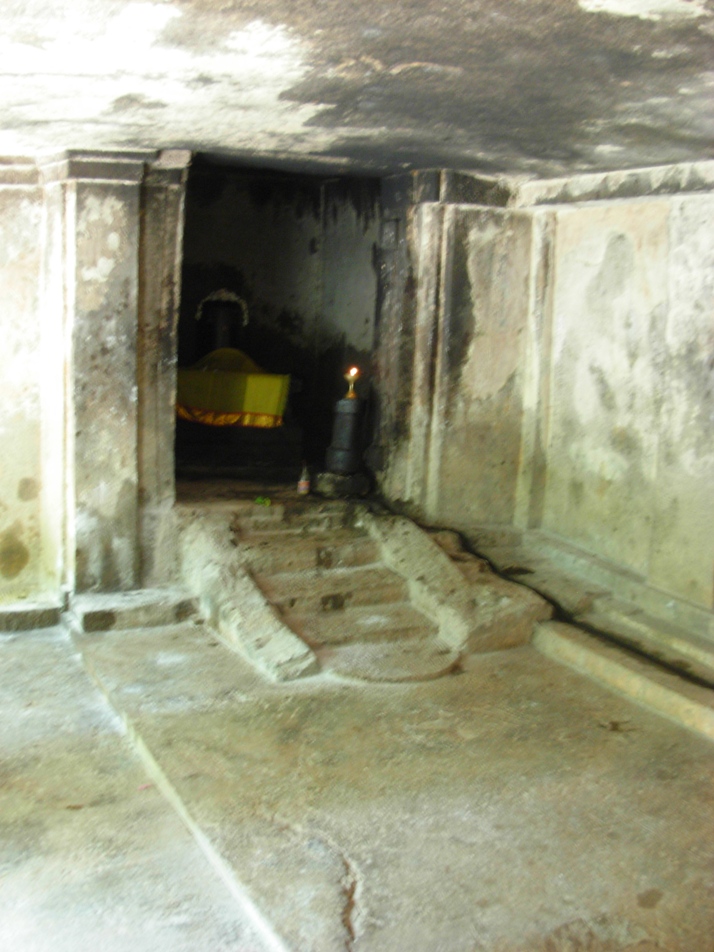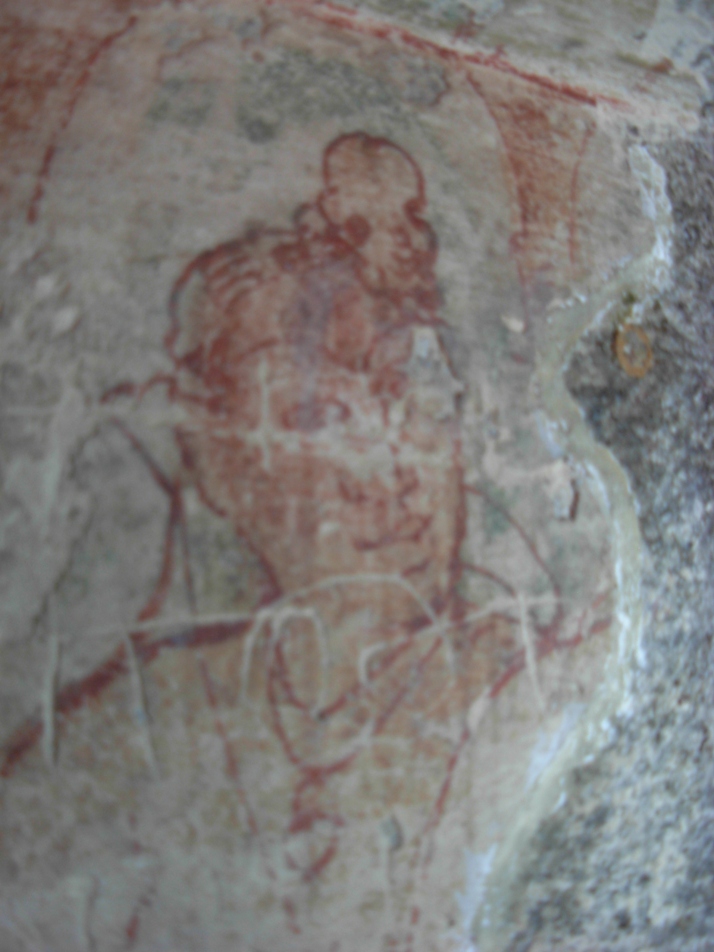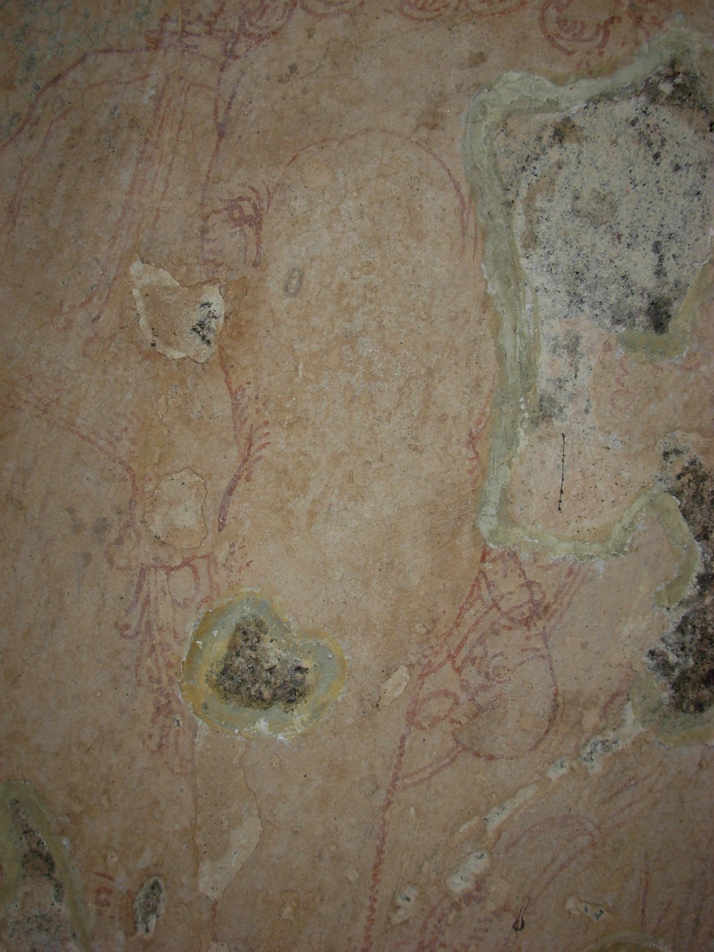 |
| Vijayanagar style Venugopala and Rukmani statues amidst fields PC The Hindu |
 |
| Renugambal Temple PC Flickr Raju |
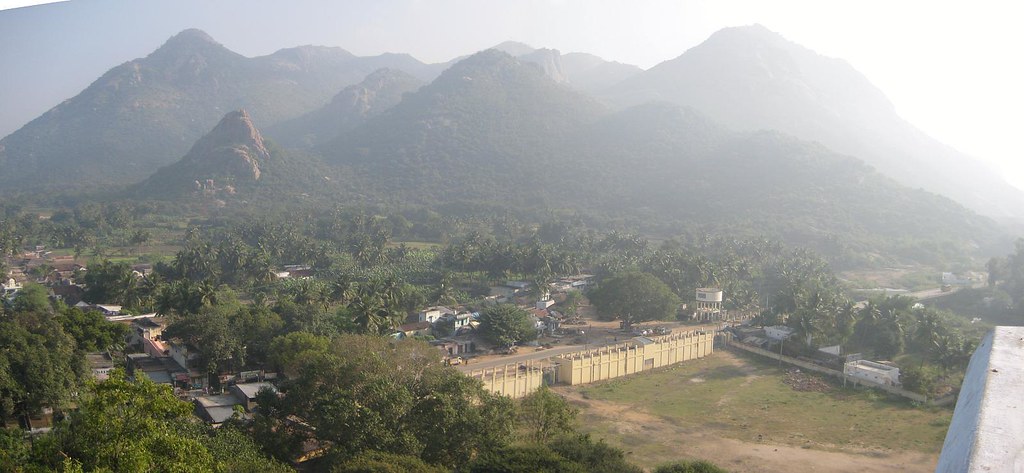 |
| Entry to Padavedu from Santhavasal PC Flickr Raju |
Sambuvaraya dynasty, who ruled in the 12th and 13th Centuries, had Munnur (முன்னூர்), Virinjipuram (விரிஞ்சிபுரம்) and Kanchipuram (காஞ்சிபுரம்) as their capitals. After becoming independent from Pandyas, Sambuvaraya chose Padaiveedu as their capital for its strategic defensive location i.e., the land bastioned by tall hills and dense forests. The formation of Malayalam forests (மலையாளக்காடு), Shenbaga grove (செண்பகத்தோப்பு) and Athtimalai (அத்திமலை) on the north-west, Kalimathu hillock (களிமத்துக் குன்று) on the south-west and Santhavasal reserve forests (சாந்தவாசல் காப்புக்காடு) on the south provided adequate defensive measures. Santhavasal was the entry point to the capital.
The scenic Javadu hill is surrounded by seventeen villages and lush green paddy fields and coconut groves. It is believed that the region was known as the 'land of thousand temples' since it was the home to 1008 Shiva temples and 108 Vishnu temples. Now it is reduced to ten ancient (12th century) temples excluding the most popular Renugambal temple (ரேணுகாம்பாள் கோவில்).
Renugambal Temple (Renuka Paramesvari Temple (ரேணுகா பரமேஸ்வரி கோவில்) also known as Yellamma Temple (எல்லம்மா கோவில்), Padavedu was built by Sambuvaraya. It is one of the most important ‘Sakthi Sthalas’ in Thondainadu. Goddess Renugambal is self-manifested here and a Banalingam is present. Adi Sankarar has consecrated the Nanakarshna Chakra This south facing ancient temple exists even today. Three inscriptions have been copied from this temple.
Also there is a newly constructed temple. The outer walls of the granite structured vimana is decorated with bas relief images depicting puranic scenes. The goddess resides in the east facing sanctum. There are ardhamandapam, mahamandapam and there are shrines minor deities.
The Sri Venugopalaswami Kainkaryam Trust,(வேணுகோபாலஸ்வாமி கைங்கர்யம் டிரஸ்ட்), a part of TVS group, takes over the village about 20 years back and maintains the age old temples flawlessly. Number of temples were identified, unearthed and renovated by the trust during 1990s. Very few of these temples retain their original facade and the temples include:
Renugambal Temple (Renuka Paramesvari Temple (ரேணுகா பரமேஸ்வரி கோவில்) also known as Yellamma Temple (எல்லம்மா கோவில்), Padavedu was built by Sambuvaraya. It is one of the most important ‘Sakthi Sthalas’ in Thondainadu. Goddess Renugambal is self-manifested here and a Banalingam is present. Adi Sankarar has consecrated the Nanakarshna Chakra This south facing ancient temple exists even today. Three inscriptions have been copied from this temple.
Also there is a newly constructed temple. The outer walls of the granite structured vimana is decorated with bas relief images depicting puranic scenes. The goddess resides in the east facing sanctum. There are ardhamandapam, mahamandapam and there are shrines minor deities.
The Sri Venugopalaswami Kainkaryam Trust,(வேணுகோபாலஸ்வாமி கைங்கர்யம் டிரஸ்ட்), a part of TVS group, takes over the village about 20 years back and maintains the age old temples flawlessly. Number of temples were identified, unearthed and renovated by the trust during 1990s. Very few of these temples retain their original facade and the temples include:
| PC Tamilnadu Tourism |
- Lord Venugopala Swamy temple (வேணுகோலஸ்வாமி கோவில்) is located on the top of Rajagambhiramalai (hill top) popularly known as Kottaimalai (Athimalai). The temple opens only on Saturdays from 9 am to 4 pm. A ghat road runs through the dense forest and leads to the hill top. People used to travel by using the off-road wheeled tractor from the foothill to the hill top over this bumpy route.
- Yoga Ramachandraswamy Temple (யோக இராமச்சந்திரஸ்வாமி கோவில்), Padavedu, constructed before 12th Century AD, is located 1 km west of Renugambal Temple. Lord Rama is uncommonly seated in Artha Padmasana posture showing “Chin Mudra” and his hand is not holding his bow (Kothandam). He is accompanied by his consort Seetha and brother Lakshmana by his side. Hanuman appears seated before Rama and engaged in reading Palm leaf manuscripts. Lord Rama is also appear seated and showing 'Chin Mudra' at Nedungunam and Ragunatha Samudram temples, both are located in Tiruvannamalai dist..
- Lakshmi Narasimhar Temple (லட்சுமி நரசிம்மர் கோவில்), Ramanathapuram, Padavedu located on a hill top. Kamandala river (கமண்டல நதி) flows by the side of this temple. It was built by Mankonda Sambuvarayar (மண்கொண்ட சம்புவராயர்). Temple ruined due to natural disaster and now renovated by TVS Group trust. The bridge, built at a later date by the trust, connects the temple and the village. Also there is a cement path leading to the hill top. Goddess Lakshmi is seated on the right side of Narasimhar.
- Velmurugan temple (வேல்முருகன் கோவில்) is located on top of Natchathra Kundru (நட்சத்திரக் குன்று) (Star Hill). A Vel (வேல்) (lance of Lord Muruga) is consecrated by the Bhogar (போகர் சித்தர்), one of the 18 Siddhars and Poojas are performed daily.
- Chinna Kottai Varadhar Temple, Padavedu is located 2 km north west of Renugambal temple.
- Kailasa Vinayagar Temple (கைலாச விநாயகர் கோவில்), Padavedu is located on the northern side of Renugambal temple with a distance of 2 km. The prime deity Lord Vinayagar is huge and has a height of five and a half feet and looks very majestic. The ancient temple built hundreds of years back was fully destroyed. The renovation work of this temple was carried out by TVS trust.
- Rishi Temple (ரிஷி கோவில்) or (Lord Budha Temple) is located near Renugambal Temple. Rishi idol was retrieved at this spot and consecrated in the newly built temple.
- Ammayappa Esvarar Temple, Padavedu, a 12th century temple, is considered as the most ancient temple and located one km west of Renugambal temple. It is the family deity of Sambuvarayas. The prime deity is Ammayappa Esvarar (Lord Shiva) and his consort is five feet tall goddess Aparnambigai. The temple totally buried due to sand storms and excavated. The procession deities hidden underground were also discovered and installed in Utsava Mandapam.
- Periya Kottai Varadhar Temple, Padavedu is located 2 km north west of Renugambal temple.
- Sadasivan Temple (சதாசிவன் கோவில்) is devoted to Lord Shiva and his consort and located in Vettagiripalayam, Padavedu.
- Kailasanathar Temple (கைலாசநாதர் கோவில்), Kailasaparai (கைலாசப் பாறை), Padavedu is totally in ruin and is located towards north on top of Kailasaparai hillock. There is no provision for flight of steps to climb. The prime deity is Lord Kailasanathar (Lord Shiva) who appears with his consort Parvathi in a ruined sanctum (no ceiling). The four hands of the Lords are lost. Also a Shivalingam is found. Vimanam is in Gajaprishta style. No pooja rituals are performed.
- Subramanya Swamy Temple is located on a hill top, on the southern side of Arulmigu Renugambal Temple. The flight of three hundred well laid stone steps leads to this hill temple.
- The village once had eight Anjaneya statues placed in eight cardinal directions to guard the place. Now only five of them remain. Installation of guardian deities is characteristic of the Vijayanagar empire. Veera Anjaneyar Temple is located on the way leading to Ramar temple from Renugambal temple and also located close to the Draupadhi Mandapam. Eight feet tall sthanaka Veera Anjaneyar appeared majestically in open air. Only 3 years back the Lord was consecrated to the present shrine.
 |
| Yoga Ramachandraswamy Temple, Padavedu PC Tamilnadu Tourism |
 |
| Venugopala Swamy temple, Rajagambhiramalai (Kottaimalai) PC Tamilnadu Tourism |
 |
| Kailasanathar Temple, Kailasaparai, Padavedu. PC Tamilnadu Tourism |
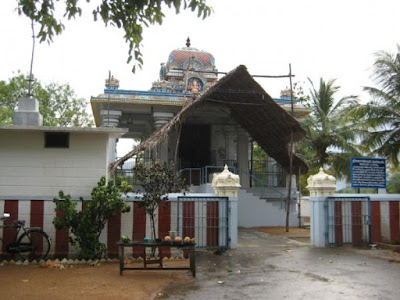 |
| Kailasa Vinayagar Temple, Padavedu PC Tamilnadu Tourism |
Sambuvaraya Dynasty
Sambuvaraya kings (சம்புவராய மன்னர்கள்) hailed from Velir clans (வேளிர் குலம்). The Velirs were minor feudatory chieftains in the ancient Tamilakam. They were vassals as well as rivals of Chola, Chera and Pandyas and maintained marital relationships with them and enjoyed coronation rights. During 12th and 13th Centuries, the Sambuvarayar chieftains ruled Tondaimandalam region. Ethirili Chola Sambuvaraya (எதிரிலி சோழ சம்புவராயர்) , who ruled the northern part of Tondaimandalam, was.a vassal under Rajadhiraja Chola II (இரண்டாம் இராஜதிராஜ சோழர்) and Kulotunga Chola III (மூன்றாம் குலோத்துங்க சோழன்) and this chieftain hailed from the family of Sengeni. Omaindha Munnutruvan Palliyana Karanamanikyam (செங்கேணி ஓமைந்த முந்நூற்றுவன் பள்ளியன் கரணமாணிக்யம்) was his ancestor. His father was Sengeni Ammaiyappan Kannudaiya Peruman Vikrama Chola Sambuvarayar (செங்கேணி அம்மையப்ப கண்ணுடைய பெருமான் விக்கிரம சோழ சம்புவராயர்). He was decorated with the titles such as Virasani (விராசனி), Viruchola (வீறுசோழ) and Pallavandan (பல்லவந்தன்).
Sambuvarayas stationed their troops to maintain and guard at Padavedu fort and hence the name 'Padaiveedu' (garrison or fortified military post) and inscriptions mention this as Marudaraisan Padaiveedu (மருதரைசன் படைவீடு) (Cantonment of the king Madurai). At the time Sambuvarayas were under the patronage of Pandyas. During the reign of Jatavarma Sundara Pandya I ((Tamil: முதலாம் சடையவர்மன் சுந்தரபாண்டியன்) (1250 - 1268 A.D). Sundara Pandya Sambuvaraya was ruling the land as a feudatory from Kanchipuram (ref. inscription at Kalavai S.I.I. vol XII no. 446).
Sambuvarayas stationed their troops to maintain and guard at Padavedu fort and hence the name 'Padaiveedu' (garrison or fortified military post) and inscriptions mention this as Marudaraisan Padaiveedu (மருதரைசன் படைவீடு) (Cantonment of the king Madurai). At the time Sambuvarayas were under the patronage of Pandyas. During the reign of Jatavarma Sundara Pandya I ((Tamil: முதலாம் சடையவர்மன் சுந்தரபாண்டியன்) (1250 - 1268 A.D). Sundara Pandya Sambuvaraya was ruling the land as a feudatory from Kanchipuram (ref. inscription at Kalavai S.I.I. vol XII no. 446).
Vira Pandya Sambuvaraya, the son of Sundara Pandya Sambuvaraya was also a loyal feudatory of Pandya. Sambuvaraya became independent after the Delhi Sultans uprooted Pandyas. They made Padaiveedu as their capital and ruled till the rise of Vijayanagar kingdom in Karnataka.
Inscription A.R.E 18 of 1889 mention this region as the 'Rajagambhira Rajyam' (இராஜகம்பீர இராஜ்யம்) named after Rajagambhira Sambuvraya (இராஜகம்பீர சம்புவராயர்) (1236 - 1268 A.D.) as well as 'Padavittu Rajyam' (படைவீட்டு இராஜ்யம்). The bordering hillock around the Padaiveedu is mentioned in an inscription no. A.R.E no. 220 of 1919 as 'Rajagambhiran Malai' (இராஜகம்பீரன் மலை) which also named after Rajagambhira Sambuvrayar. The capital of this illustrious kingdom was mentioned as 'Marudaraisan Padaiveedu,' in inscription S.I.I vol. 1, no. 81 Sambuvaraya rulers built their palace structures and protected them with 'Rajagambhiram Fort' and a wide moat.
Ekambaranatha Sambuvaraya (ஏகாம்பரநாத சம்புவராயர்), a Sambuvaraya feudatory under Maravarman Kulasekara Pandya (மாறவர்மன் குலசேகர பாண்டியன்), ruled parts of Tondaimandalam independently from 1306 AD. An inscription from Tiruvannamalai district speaks about this subject. Ekambaranatha Sambuvaraya witnessed the invasion of Malik Kafur (மாலிக் காபூர்) in 1311 A.D and Kushru khan (குஸ்ரு கான்) in 1319 A.D. In 1322 Ekambaranatha Venru Mankonda Sambuvaraya (ஏகாம்பரநாத வென்று மண்கொண்ட சம்புவராயர்) (1322 - 1337 A.D.), the son and successor of Ekambaranatha Sambuvaraya became the ruler of a major portion of Tondaimandalam. The village donated to great vedic scholars by this Sambuvaraya king after he won in the war, hence the village is called Mankonda Kolathur (now termed as Mandakolathur) and the king was known in the name of Vendru Mankonda Sambuvaraya. Also during his reign in 1324 A.D. Mohamed Bin Tugklaq's army invaded the land and destroyed many Hindu shrines. Tiruvamathore (திருவாமத்தூர்) (Villupuram District) inscription informs about the renovation of the destroyed temples by the Sambuvarayar king.
Venru Mankonda Sambuvarayar was succeeded by Rajanarayana Sambuvaraya I (முதலாம் இராஜநாராயண சம்புவராயர்) (1337 - 1373 A.D.). In the year 1363 Vira-Kampana-Udaiyar (வீர கம்பண உடையார்), also known as Kumara Kampanna II (இரண்டாம் குமார கம்பண்ணா) , second son of Bukka Raya I (முதலாம் புக்க இராயர்) and the prince of Vijayanagar who ruled from Kanchipuram, attacked Rajanarayana Sambuvarayar I and captured him as the prisoner.
Rajagambhiram fort
During 11th regnal year (1247 A.D.) Rajagambhira Sambuvarayar (1236 - 1268 A.D.) built Rajagambhiram fort on top of the hill, 'Rajagambhiran Malai.' An inscription on top of the hill informs about this. The fort straddled the entire hill. They have used granite boulders and 10 inches by 7 inches bricks, sand and lime mortar to construct the fort wall. The perimeter of the fort extends up to two kilometers. In fact this fort was hard to conquer for it can be accessed only through four gates and cannot be accessed easily through other means. It was constructed for surveillance and control the movements Delhi Sultanates and Vijayanagar rulers. The fort had provision for shelters for soldiers posted on surveillance duties. The rock surface do show pits for erecting poles for tents and they could have erected nine tents on top of the hill. They have also made provision for storing water in tanks as well as in natural ponds. They have also made one foot diameter by one foot deep pits for provision and use of mortar weapon. The fort also exhibits evidences for the existence of temples dedicated to Lord Shiva and Lord Vinayaga.
The northern gate is presently called as Santhavasal (Santha gate). A hero stone is discovered near Santhavasal. The eastern gate is in ruined state and the western gate, named after Puvandai alias Cholakon, one of the Mudalis in the military service of Ethirili Chola Sambhuvaraya, is fully destroyed. There was a moat encircling the fort.
Rajagambhiram fort
During 11th regnal year (1247 A.D.) Rajagambhira Sambuvarayar (1236 - 1268 A.D.) built Rajagambhiram fort on top of the hill, 'Rajagambhiran Malai.' An inscription on top of the hill informs about this. The fort straddled the entire hill. They have used granite boulders and 10 inches by 7 inches bricks, sand and lime mortar to construct the fort wall. The perimeter of the fort extends up to two kilometers. In fact this fort was hard to conquer for it can be accessed only through four gates and cannot be accessed easily through other means. It was constructed for surveillance and control the movements Delhi Sultanates and Vijayanagar rulers. The fort had provision for shelters for soldiers posted on surveillance duties. The rock surface do show pits for erecting poles for tents and they could have erected nine tents on top of the hill. They have also made provision for storing water in tanks as well as in natural ponds. They have also made one foot diameter by one foot deep pits for provision and use of mortar weapon. The fort also exhibits evidences for the existence of temples dedicated to Lord Shiva and Lord Vinayaga.
The northern gate is presently called as Santhavasal (Santha gate). A hero stone is discovered near Santhavasal. The eastern gate is in ruined state and the western gate, named after Puvandai alias Cholakon, one of the Mudalis in the military service of Ethirili Chola Sambhuvaraya, is fully destroyed. There was a moat encircling the fort.
Madura Vijaya ('The Conquest of Madurai')
 |
| PC Wiki media |
“King Kampana, then converted the Tamil king’s town into an encampment for his own force, and from there began to lay siege to the hill fortress named Rajagambhira (Rajagambhiramalai) in which the enemy had sought asylum.
The sound of his war drums raised echoes from every cave of the hill and it looked as if the hill itself had begun to yell out in freight.
With the flags flying in the direction of high winds, the hill (fort) gave the impression that it was greeting king (Kampana) and welcome him with its arms (the flags) to come up to its top.
Again, fierce fighting commenced between the two sides, and the weapons falling down and shooting up, lit up both earth and sky by their resplendence.
Heads severed by arrows resembled palmyra fruits as they fell down from the ramparts and caused an illusion that the balls belong to the deity of war (for playing (with).
Like messengers (tax-collectors) sent by the strong hold themselves claiming the tolls for the entry (of the Karnataka troops) the stones let down from the catapults fell just in front of the king.
The hill, with the houses lit up by fire from the missiles of bow-men looked like holding the lamp in readiness harati for the happy ceremony to mark the auspicious victory of the king.
With all means (and chances of escape) coming completely blocked, the strong hold was subjected to such great distress that embryos of women, big with children slipped out at the very sight of the fierce jumping in, and people immersed in the river of blood of the slain prayed for their life.
Sambuvaraya, the monarch withdrawn sword, came out of his palace in great anger, even as a snake with its lolling tongue might come out of a mole-hill.
Though many a soldier of valour eagerly came forward to fight saying “let me do it,” King Kampana preferred to face the Sambuvaraya himself.
With forepart of their body bent and eyes fixed, the two kings sword in hand, stood still for a moment like a picture on a piece of painting.
The gods were thankful for the total absence of winking their eyes, as they looking on with fixed gaze, the flight (of the two horses) their bodies divided at the waist.
Kampana’s sword, reflecting as it the image of the Sambuvaraya monarch, looked like a pregnant daughter about to give birth to a husband for the celestial nymphs.
Then escaping deftly a sword thrust, King Kampana despatched the Sambuvaraya (monarch) as a guest to Indra’s city.
Having thus reduced (killed) Sambuvaraya in the field of battle, King Kampana received the decree of his father that he should rule (the territory he conquered).”
From the above poem it is presumed that there was a palace and huge fort wall, both of which were guarded by large number of soldiers, wielded by bow and arrows and lances. The citadel located in the Rajagambhiram hill was sieged and the ruler was stabbed to death by Vira Kampana in 1361 A.D. After this Vira Kampana marched to Kanchipuram and conquered.
In 1311 A.D. Malik Kafur attacked Madurai and plundered all temples. Ghiyasuddin Tughlak made second invasion to Madurai and established Madurai Sultanate. Madurai suffered a lot during 1335 - 1371 A.D. The temple remain closed for nearly 40 years. Madura Vijaya details the sufferings of Hindus in the hands of Madurai Sultans. Hoysala ruler Veera Vallala encountered with Sultan and was killed in the battle. The huge army of Vira Kampana stormed Madurai Sultanate and Vira Kampana killed the Madurai Sultan Qurbat Hasan Kangu in the battle. Later the entire Madurai country and Chola country were included with Vijayanagar kingdom. Two divisions namely Rajagambhira Rajyam and Tiruvathigai Rajyam were formed.
Padavedu Excavations
The Tamil Nadu State Department of Archeology conducted excavations in Padavedu in the year 1992-93 at two sites namely Vetagiripalayam (வேட்டைகிரிபாளையம்) and Kottaikaraimedu (கோட்டைக்கரைமேடு). The existence of the palace and the fort wall was ascertained by the Department of Archeology during excavations. A mound, just on the west of Padavedu village, was popularly known as 'Kottaimedu' (கோட்டைமேடு). Kottaimedu is located one km away from Yoga Ramachandraswamy temple. Presently the Kottaimedu lands have been converted into cultivable patta land and paddy, sugarcane and plantain crops are cultivated. Two Vishnu idols namely Chinna Kottai Varadar (சின்னக்கோட்டை வரதர்) (Varadar of Small Fort) and Periya Kottai Varadar (பெரியகோட்டை வரதர்) (Varadar of big fort) were found near the Kottaimedu mound. Sculptures of Kottai Talayari (கோட்டைத் தலையாரி), Viraanjaneya (வீரஞ்சநேயர்), Mahaganapathy (மகாகணபதி) and two Tirthankaras (தீர்த்தங்கரர்கள்) were discovered in 'Kottaimedu' itself. The sculptures found in these locations clearly lead the archaeologists to conclude that there was a fort at the site. Further to this, occurrence of bricks in huge quantities as well as sizable number of ring wells also suggest the presence of fort at the site. The traces of fort gates on the Kottaimalai (Athimalai) (அத்திமலை) or Rajagambhiram hill and the existence of Venugopala temple and brick graneries assignable to Nayak period suggest the scholars to conclude about the fort.
The team laid 14 trenches. At Vetagiripalayam two trenches were laid to fully expose the age old brick structure appeared out due to rain. At the first trench they discovered terracotta tube with a tiny hole (bellows tube) (துருத்திக் குழாய்). It could have been the mechanical device, made in clay, used as blow pipe for glass making. The glass slag piece retrieved from this trench supports this view. The second trench dug to the west of the first trench exposed the relics of the brick wall fully.
At Kottaikaraimedu twelve trenches were laid. This site is marked with the occurrence of brick structure, with the channels used for bringing drinking water and draining out sewage water and ring wells. They have used granite boulders to construct both the sides of the wall and filled the middle portion with the mixture of clay and crushed brick stones and they could ascertain the width as 1 m 15 cm and the height of the brick wall structure could not be ascertained. The site is marked by the presence of smoking pipes, Sultan coins and a number of decorated red ware shreds and bangle pieces were collected from this site.
On the basis of cultural sequences of these sites, the archaeologists have classified as period one and period two. The date assignable to period one could be between 13th and 14th Century A.D. The date assignable to period two could be between 14th and 16th century A.D.
InscriptionThe team laid 14 trenches. At Vetagiripalayam two trenches were laid to fully expose the age old brick structure appeared out due to rain. At the first trench they discovered terracotta tube with a tiny hole (bellows tube) (துருத்திக் குழாய்). It could have been the mechanical device, made in clay, used as blow pipe for glass making. The glass slag piece retrieved from this trench supports this view. The second trench dug to the west of the first trench exposed the relics of the brick wall fully.
At Kottaikaraimedu twelve trenches were laid. This site is marked with the occurrence of brick structure, with the channels used for bringing drinking water and draining out sewage water and ring wells. They have used granite boulders to construct both the sides of the wall and filled the middle portion with the mixture of clay and crushed brick stones and they could ascertain the width as 1 m 15 cm and the height of the brick wall structure could not be ascertained. The site is marked by the presence of smoking pipes, Sultan coins and a number of decorated red ware shreds and bangle pieces were collected from this site.
On the basis of cultural sequences of these sites, the archaeologists have classified as period one and period two. The date assignable to period one could be between 13th and 14th Century A.D. The date assignable to period two could be between 14th and 16th century A.D.
 |
| Structural Remains and Flooring PC Dept. of Archeology |
 |
| Closed Channel PC Dept. of Archeology |
S.I.I Vol. V, No.78. on the east and north bases of the Ammaiappa esvara Temple, Padavedu
Inscription S.I.I. vol V, no. 78 dated - on the nakshatra Revati and Monday, the seventh lunar day of the former half of the month of Karkataka, in the year, which was current after the expiration of the Saka year 1180 (1258 A.D.), and records a grant, which Rajagambhira-Sambuvarayan made to the temple of Ammaiappa esvara. The name of the object of the grant must be contained in the final portion of the first line, which is buried underground. The donor is evidently identical with that Rajagambhira-Sambuvarayan, who is mentioned in a Tirumalai inscription (No.74), which seems to be dated in Saka 1157-58. It may be further conjectured, that the Ammaiappesvara Temple at Padavedu had received its name from Ammaiappan or Ammaiyappan, one of the birudas of another Sambuvarayan, who was a contemporary and probably a relation of Rajagambhira-Sambuvarayan.
S.I.I Vol. V, No.79. on the south-east of the Ammaiappa esvara Temple, Padavedu
This inscription is dated during the reign of Vira-Devaraya-maharayar (of Vijayanagara) and On the tenth day of the month of Masi of the Pramadicha (i.e., Saka 1356) (1434 A.D.). It records a grant to the lord Ammaiappa-nayanar of the Ammaiappa eswara Temple. The name of the donor is obliterated (Madhayavanar?). This meritorious gift shall last as long as the moon and the sun. He who shall injure this meritorious gift, [shall incur the sin of one has killed] a black cow on the bank of the Ganga.
S.I.I Vol. V, No.80. on the south wall of the Ammaiappa esvara Temple, Padavedu
This inscription is dated during the reign of Vira-Devaraya-maharayar (of Vijayanagara) and on the 2nd day of the month of Adi on the Ananda year,. (i.e.,Saka 1357). It records the gift of a village to the lord Ammaiappa-nayanar of the Ammaiappa esvara Temple. The middle portion is defaced by three cracks. The donor is Ulagalantha Suryadeva of Kalavai.
S.I.I Vol. V, No.81. on the east wall of the Somanatha eswara Temple, Padavedu
This inscription is dated on the day of (the nakshatra) Uttiradam, which corresponds to the Yoga Ayushmat and to Saturday, the thirteenth lunar day of the former half of the month of Simha of the Sukla year, which was current after the Saka year 1371 (had passed) (1449 A.D.), and during the reign of Virapratapa Praudha-Immadi-Devaraya-maharayar. This is the latest hitherto-known date of Devaraja II. In the preserved portion, mention is made of the kingdom of Padaividu (Padaivitttu rajyam),which belonged to Tondai-mandalam, of the right and left had castes and of the Somanatha esvara Temple at Padaividu.
Nearest Bus stand: Padavedu is located around 30.9 km away from Vellore and around 56.7 kilometer away from its district head quarter Tiruvannamalai. Santhavasal (Padavedu) is well connected with major nearby towns like Arani, Arcot, Vellore and Thiruvannamalai and Polur. Frequent buses ply to Santhavasal from Kancheepuram, Vellore, Polur, Arcot and Arani.
Nearest Railway station: The nearest railway station to Padavedu is Aliyabad which is located in and around 11.5 km distance. Both Arni Road railway station and Vellore Cantt. railway station are 28.8 km away from Padavedu..
Nearest Airport: Chennai airport is the nearest airport located at a distance of 139.7 km. Bengaluru airport is also a nearer airport located at a distance of 211.8 km.
Nearest Airport: Chennai airport is the nearest airport located at a distance of 139.7 km. Bengaluru airport is also a nearer airport located at a distance of 211.8 km.
- Discussion why pandyas lost to kafur. in Ponniyin Selvan Varalaatru Peravai (http://ponniyinselvan.in/forum/discussion/47339/why-pandyas-lost-to-kafur/p1)
- Land of a thousand temples. Anusha Parthasarathy. The Hindu June 27, 2013
- Maduravijayam. Gangadevi. Tr. by Tiruvenkatachari. Canto IV, Slokas 64 - 83.
- Madura Vijayam Wikipedia
- Padavedu Excavation. Natana Kasinathan. Asst. by Abdulmajeed, Sampath KS, Selvaraj S, and Kalaivanan M, State Department of Archaeology, Chennai. 1993 (http://210.212.62.26/pdf_files/books/PADAVEDU%20EXCAVATION%20part%20002.pdf) and (http://210.212.62.26/pdf_files/books/PADAVEDU%20EXCAVATION%20part%20003.pdf)
- Padavedu, Thiruvannamalai. Tamilnadu Tourism. March 24, 2016. (http://tamilnadu-favtourism.blogspot.in/2016/03/padavedu-thiruvannamalai.html)
- Sambuvaraya Wikipedia
- Sambuvarayar period stone inscription found The Hindu. April 07, 2002
- Visit to Padavedu Kottaimalai Sri Venugopala Swamy Temple. Raju's Temple Visits. June 13, 2008 (https://shanthiraju.wordpress.com/2008/06/13/kottamalai/)
- Visit to Padavedu Temples. Raju's Temple Visits. May 26, 2008. (https://shanthiraju.wordpress.com/2008/05/26/padavedu/)
- What is India. South Indian Inscriptions. Part B: Tamil and Grantha Inscriptions. V Inscriptions at Padavedu (http://www.whatisindia.com/inscriptions/south_indian_inscriptions/volume_1/padavedu.html)
YouTube
Mann Pesum Sarithiram epi 290
Kottaimalai Trip
Vel Temple at Padavedu






